ISSN ONLINE(2319-8753)PRINT(2347-6710)
ISSN ONLINE(2319-8753)PRINT(2347-6710)
Visit for more related articles at International Journal of Innovative Research in Science, Engineering and Technology
This study presents experimental measurements of complex dielectric constant at C-band microwave frequency of dry and moist saline soils collected from Dandi (Dist. Navsari) site of Gujarat state (India). An automated microwave set-up tuned at 5.3 GHz frequency is used for this purpose. Measured values of dielectric constant are then used to estimate the scattering coefficient by using perturbation model. Our results indicate relatively lower rate of increase in ε' and order of magnitude higher values of ε'' for these saline soils when their gravimetric MC is changed from 10 to 30% than that reported for non-saline soils by earlier researchers. Further, at constant value of MC, scattering coefficient of soil sample also increases with increase in the incident angle for vertical polarization, and this increase continues up to angles between 60o to 70o, at which it reaches maximum value and beyond this, it decreases sharply. Further, for vertical and horizontal polarizations, at constant value of incident angle, our results indicate relatively lower rate of increase in scattering coefficient values for saline soils than reported earlier for non-saline soils when gravimetric MC is changed from 10 to 20%. This data is very useful in understanding dielectric behaviour of saline soils and also for designing the active sensors for these soils.
Keywords |
| Dielectric Constant, Dielectric Loss, Scattering Coefficient, Saline Soil, C-band Microwave Frequency. |
I. INTRODUCTION |
| Now-a- days, remote sensing using microwave techniques is the emerging field for the study of natural resources of earth. Microwave remote sensing of natural earth materials such as soil and water has a very close dependence on their electrical parameters. The most important parameter is the dielectric constant. Microwave remote sensing of soil moisture relies on the large contrast between the dielectric constant of water (80) and that of dry soils (2 to 4). As the water content of a dry soil increases the dielectric constant rises consequently, which directly affects the backscattering coefficient [1]. The knowledge of dielectric constant and scattering coefficient of the soil helps in the study of dry and wet soils using microwave sensors. Several researchers have reported the findings of their studies on dielectric and scattering characteristics of soils from various parts of the world at different microwave frequencies [2-19]. However, most of these reported studies were related to the fertile or non-saline soils. |
| Compared to studies that evaluate the relationship between permittivity and soil water content, those studying the relationship between the dielectric constant, soil salinity and the backscattered coefficient are rare. In this paper, we have studied the effect of salinity/electrical conductivity of soils on the complex dielectric constant and hence on the scattering coefficient for the C-band frequency. Salinity is one of the principal environmental causes of soil degradation. Salinity usually causes a reduction in the biomass. Approximately seven percent of soils all over the word suffer from this phenomenon [20]. |
| The presence of soluble salts in the soil solution also has a direct effect on the value of the dielectric constant. The imaginary part of the dielectric constant of water is sensitive to salinity when microwave frequencies are below 10 GHz, whereas the real part of the dielectric constant of water is sensitive to salinity with frequencies >5 GHz [21]. In general, an increase in salinity increases the dielectric constant, as the salinity moves up conductivity. This effect is higher at frequencies <3 GHz [22]. Due to this effect, salt affected soils can be detected with radar, but in this case, surface roughness and vegetation effects must be eliminated to accurately measure soil moisture [23]. |
| The main aim or objective of the present research work is to provide the detailed ground truth experimental data on the dielectric and scattering properties like dielectric constant (ε'), dielectric loss (ε'') and scattering coefficient and to study their variation with moisture content (MC) for four different saline soil samples at C-band microwave frequency, 5.3 GHz. The estimated values of scattering coefficients are needed in designing active sensors for microwave remote sensing. Such studies are necessary for correlating the remote sensing data available from satellites. This confirms the need and importance of the research work reported in the present study. |
II. MATERIALS AND METHODS |
| Preparation of soil samples |
| In the present investigations, four different soil samples were collected from various locations lying in an area about 6 km2 of Dandi (Dist. Navsari) site of Gujarat state. These samples have high salinities and their depths ranging between 0-20 cm. These topsoil samples are first sieved by gyrator sieve shaker (size 425 μm) to remove the coarser particles. The sieved out fine particles are then dried in the hot air oven to a temperature around 110oC for about 24 hours in order to completely remove any trace of moisture. Such dry samples are then called as oven-dry or dry base samples when compared with wet samples. Soil samples of various gravimetric moisture contents are prepared by adding an exact amount of distilled water to the known mass of the oven dry soil. The soil-water mixtures are well mixed and are kept in a closed container for proper settling over several hours. |
| Physico-chemical Analysis of Soil Samples |
| All the four soil samples were analysed for the status of available nutrients and other physico- chemical properties by standard analytical methods from Soil Testing Laboratories of Agricultural College, Pune. The detailed report on Physical and chemical analysis of Dandi (Gujrat) soil samples is given in Table 1 and 2, respectively. From Table 1, we see that almost all the soil samples have slightly lower values of bulk densities than the normal specified range. Further, these four soil samples show Wilting Point (WP) variations over the wide range from 0.106 to 0.193. Wang and Schmugge model [24] has been used for calculating the Wilting Point (WP) and Transition Moisture (Wt) of these soils. |
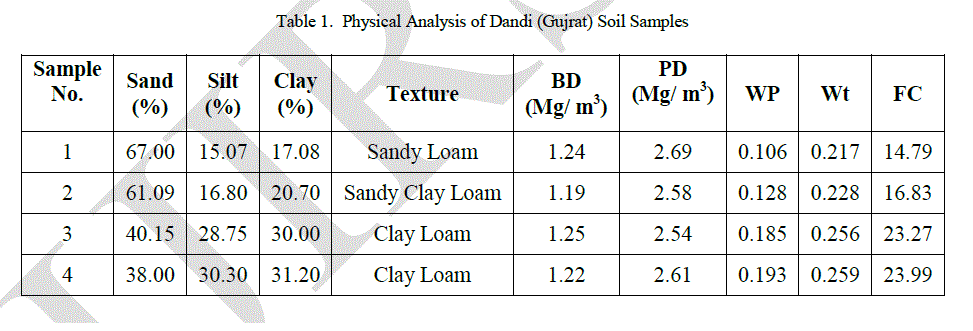 |
| Most striking features seen from Table 2 are that all these soil samples have very high values of electrical conductivity (around 100 times or more than the normal EC range) and available potassium, K (around 10to 20 times more than its critical limit). High EC values clearly indicate that all the soil samples have high salinity. pH values given in Table 2 indicates that all the soil samples are mildly or moderately alkaline. Further, these soils also have relatively higher values of copper and zinc and lower values of nitrogen and ferrous than their normal range. |
| Method of measurement of dielectric properties |
| The wave-guide cell method is used to determine the dielectric properties of the soil samples. An automated microwave set-up (Fig. 1) in the TE10 mode with Gunn source operating at desired C-Band frequencies, PC-Based slotted line control and data acquisition system are used for this purpose. It consists of Microcontroller (8051) and ADC-12 Bit- MCP (3202) Visual-Based software. The main advantages obtained due to atomization are increased resolution of output, reduction of backlash error in slotted line, visual representation of standing wave pattern. The sample lengths are usually taken in the multiples of λ/4. |
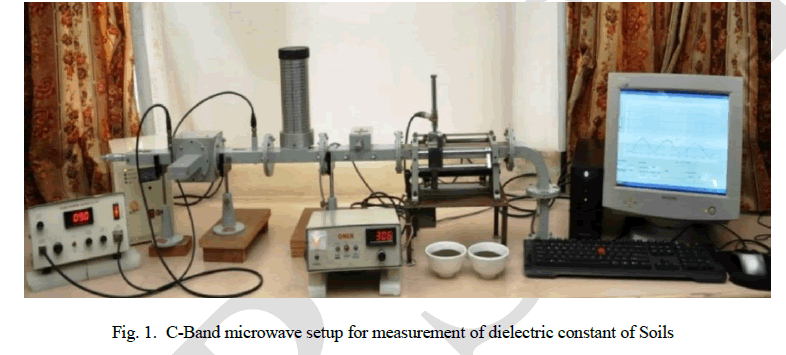 |
| The signal generated from the microwave source is allowed to incident on the soil sample. The given soil sample reflects part of the incident signal from its front surface. The reflected wave combined with incident wave to give a standing wave pattern. These standing wave patterns are then used in determining the values of shift in minima resulted due to before and after inserting the soil sample. The dielectric constant is calculated by measuring the standing wave ratio of the dielectric material and the shift in minima of the standing wave pattern in a rectangular waveguide. This shift takes place due to change in the guide wavelength when a dielectric material is introduced in waveguide. By substituting these values of shift in minima, VSWR, waveguide dimensions, guide wavelength, etc. in a well designed computer programs, the values of dielectric constant and dielectric loss of soils are determined. In order to improve the accuracy of these results, average of several readings is taken. |
 |
 |
| From the measurement of dielectric constant and dielectric loss, the scattering parameters for these saline soil samples can be determined. |
| Estimations of scattering coefficient by using perturbation model |
| Different models are to be used depending on the nature of the surface. For waveguide cell method, the surface of the soil inside the waveguide is smooth; hence the perturbation model is quite suitable [25-26]. The perturbation method requires the surface standard deviation to be less than about 5% of the electromagnetic wavelength. Accordingly, in the present case, the surface standard deviations for C- band is about 1.4 mm. The corresponding surface correlation length is around 13.2 mm. In order to apply perturbation model, the necessary conditions to be satisfied are |
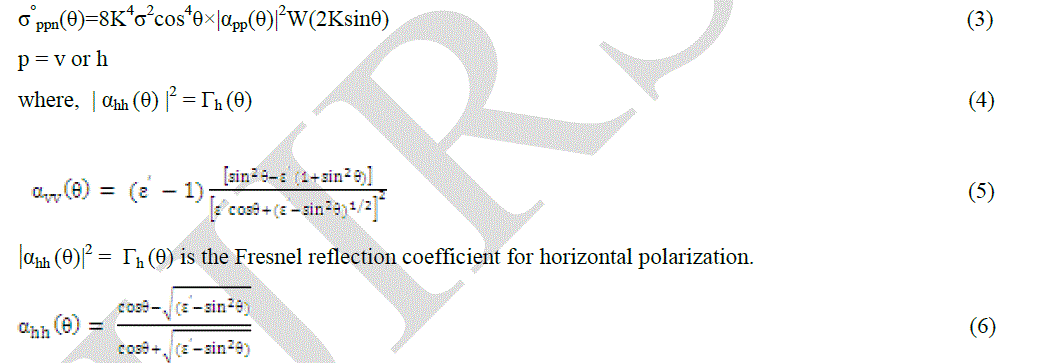 |
III. RESULTS AND DISCUSSION |
| Variation of dielectric constant with moisture content |
| Fig. 2 shows the variations of dielectric constant with different gravimetric MC (%) for four saline soil samples from Dandi (Gujrat State) site at 5.3 GHz frequency. The MC (%) of these soil samples are varied over a range from 0 % (oven dry) to around 30% for all the soil samples. For all the four soil samples studied, the dielectric constant ε', in general, is found to increase with increase in MC over the range studied. However, this variation is nonlinear and the trend is almost similar for all samples, except their relative magnitudes. Such little variations in the magnitudes may be due to differences in the physico-chemical properties of the four soil samples studied. The values of ε' ranges from 2.4 to 15.7 at 5.3 GHz and for MC changed over 0-30%. |
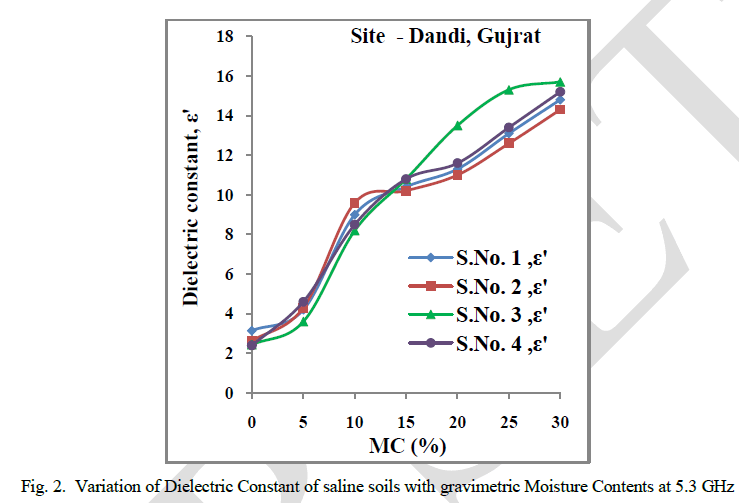 |
| These results are similar in some respects to the results obtained by numerous earlier researchers [2-14] for the moisture effects on dielectric properties of soils. But, our results indicate relatively lower rate of increase in ε' for soil samples when their gravimetric MC is changed from 10 to 30%, showing close agreement with similar studies on saline soils [21-23]. Thus, our results clearly indicates the effect of soil salinity on the real part of dielectric constant ε'. This may be mainly because of significantly very high values of electrical conductivity/salinity of these four soil samples than those used by the earlier investigators [2-14]. |
| Variation of dielectric loss with moisture content |
| Fig. 3 shows the variations of dielectric loss with different gravimetric MC (%) for all the four soil samples studied from the Dandi sites at C-band (5.3 GHz) frequency and MC (%) of soil samples are varied over a range from 0 % (oven dry) to around 30%. For all the four soil samples, the dielectric loss ε'', in general, is found to increase with increase in gravimetric MC over the range studied. However, this variation is also nonlinear and the trend is almost |
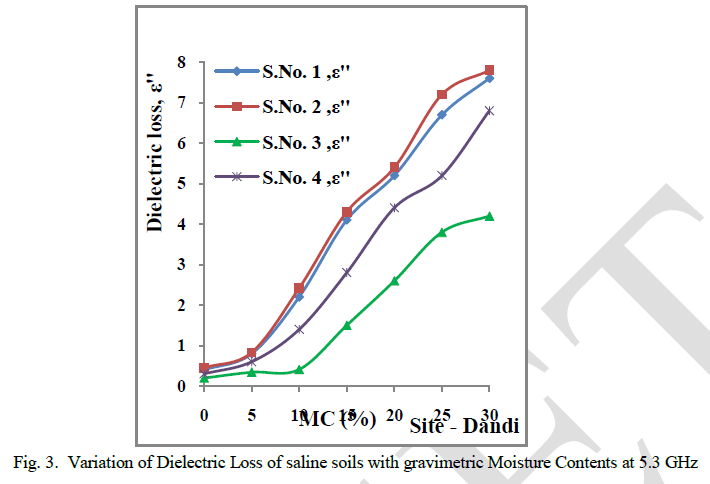 |
| similar for all cases, except their relative magnitudes. In Fig. 3, at constant value of MC (%), for the soil having relatively greater value of EC we observe correspondingly higher value of ε''. For all the soil samples from this site, the values of ε'' range from 0.20 to 7.8. Again, one striking feature of our results is that, we observe order of magnitude higher values of ε'' for these soil samples from Dandi with similar variations in MC% than for non-saline soil samples studied by earlier investigators [2-14]. This may also be mainly because of the fact that our soil samples have significantly high values of electrical conductivity (around 100 times or more than the normal EC range) and available potassium, K (around 10 to 20 times more than its critical limit) than the others. This clearly indicates that all the soil samples used in this study have high salinity. Thus, our results clearly indicates the significant effect of soil salinity on the imaginary part of dielectric constant ε'' and shows close agreement with similar studies on saline soils [21-23]. |
| Variation of Scattering Coefficient with Angle of incidence For Vertical (VV) and Horizontal Polarization (HH) at Frequency 5.3 GHz Dandi site Soil Samples |
| Fig. 4 (a-d) show the variation scattering coefficient of four soil samples with MC (%) and different angle of incidence and having three different MC (0%, 10 % and 20 %) for vertical and horizontal polarizations at 5.3 GHz frequency, respectively. The trend of variations of scattering coefficient with MC and incident angles is almost similar for all four soil samples, except their relative magnitudes. Such little variations in the magnitudes may be due to differences in the physico-chemical properties of the four soil samples studied. It is observed that at constant value of MC, scattering coefficient of soil sample increases with increase in the incident angle for vertical polarization, and this increase continues up to angles between 60o to 70o, at which it reaches maximum value and beyond this particular angle, scattering coefficient decreases sharply. Value of this angle is found slightly more for higher MC. Further, for vertical polarization, at constant value of incident angle, scattering coefficient of soil sample is found to increase significantly with increase in the values of its MC (%). |
| In case of horizontal polarization, the value of scattering coefficient for soil sample almost remains constant up to incident angles about 40-50° and then starts decreasing slowly. Beyond 50°, it decreases significantly with increase in the incident angle and at about 70-80° and, thereafter values of scattering coefficient becomes almost equal for all three MC. Thus, in general, for horizontal polarization, scattering coefficient decreases with the increase in incident angle. It is further observed that the magnitudes of scattering coefficient of soils at same incident angle are greater for vertical polarization rather than for horizontal polarization. However, for horizontal polarization, at constant value of incident angle, scattering coefficient of soil sample is also found to increase significantly with increase in the values of its MC (%), similar to vertical polarization. Thus, results/graphs presented here show similar trends and also agreement in some respects with the experimental results and theoretical predictions of earlier investigators for non-saline soils [11-19]. But, our results indicate relatively lower rate of increase in scattering coefficient values for our saline soil samples when their gravimetric MC is changed from 10 to 20%, again showing close agreement with similar studies on saline soils [21-23]. This is expected because of the direct dependence of scattering coefficient on the real part of dielectric constant. Thus, our results clearly indicate the effect of soil salinity on the scattering coefficient. |
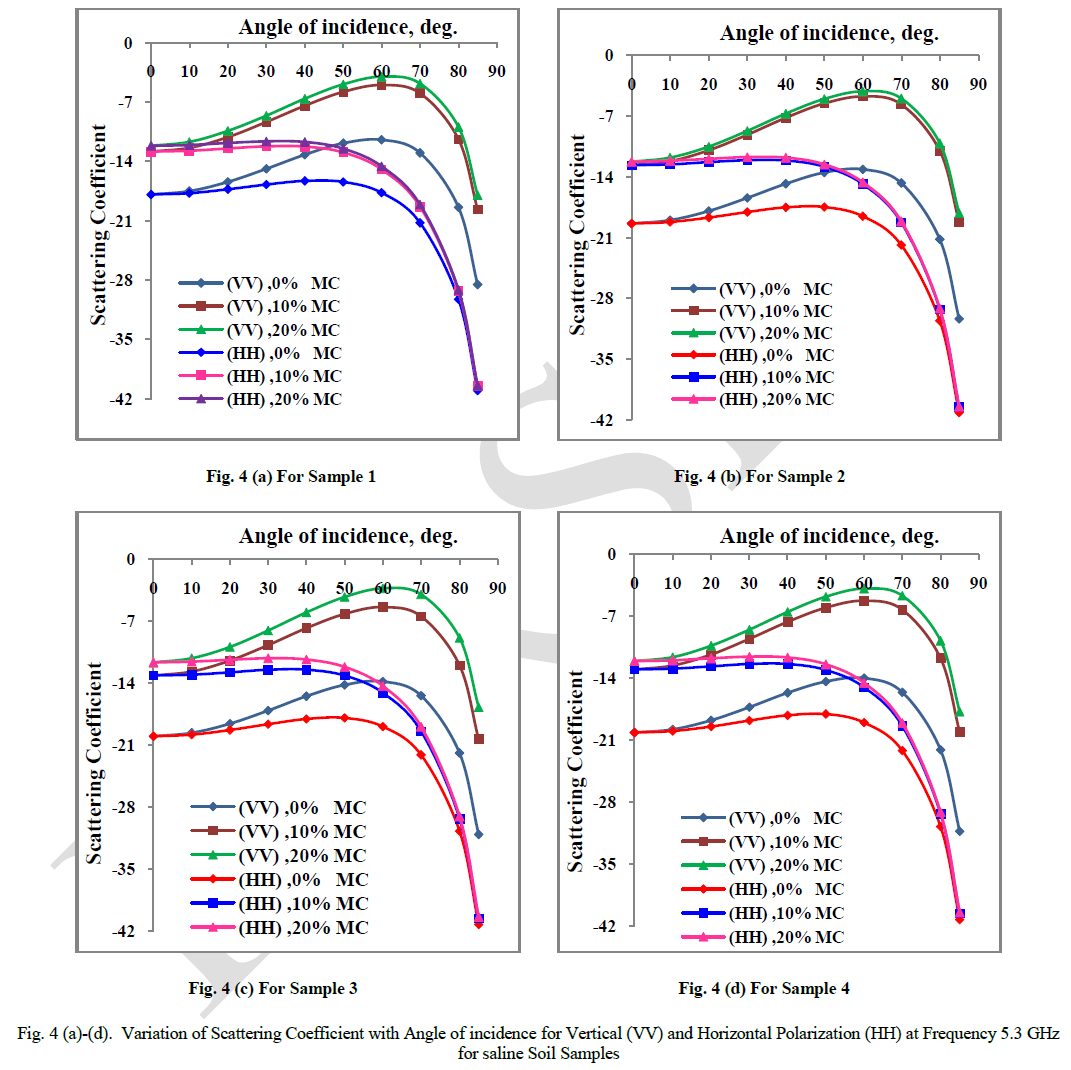 |
| The data on scattering coefficient for saline soils is quite useful in designing active sensors for such type of soils. Such sensors are very much needed for the retrieval of soil moisture content from the remotely sensed satellite data. Hence the reported study not only contributes in understanding the soil physics but also may find uses in various fields mainly in agriculture. |
IV. CONCLUSIONS |
| Complex dielectric constant of saline soils increases with increase in the MC (%) at C-band frequency. However, this variation is also nonlinear and the trend is almost similar for all cases, except their relative magnitudes. Our results further indicate relatively lower rate of increase in ε' and order of magnitude higher values of ε'' for these saline soils when their gravimetric MC is changed from 10 to 30% than that for non-saline soils reported by earlier researchers. |
| At constant value of MC, scattering coefficient of soil sample increases with increase in the incident angle for vertical polarization, and this increase continues up to angles between 60o to 70o, at which it reaches maximum value and beyond this, it decreases sharply. |
| In case of horizontal polarization, at constant value of MC, the scattering coefficient decreases with the increase in incident angle. |
| For vertical and horizontal polarizations, at constant value of incident angle, scattering coefficient of soil sample is found to increase significantly with increase in its MC (%). However, our results indicate relatively lower rate of increase in scattering coefficient values for saline soils than reported earlier for non-saline soils when their gravimetric MC is changed from 10 to 20%. Our results show close agreement with similar studies on saline soils. |
ACKNOWLEDGMENT |
| The authors are very much grateful to the Space Application Centre, ISRO, Ahmedabad (India) for providing funds to carry out this research and also Principal, JET’s Z. B. Patil College, Dhule for his kind co-operation and encouragement during this work. |
References |
|